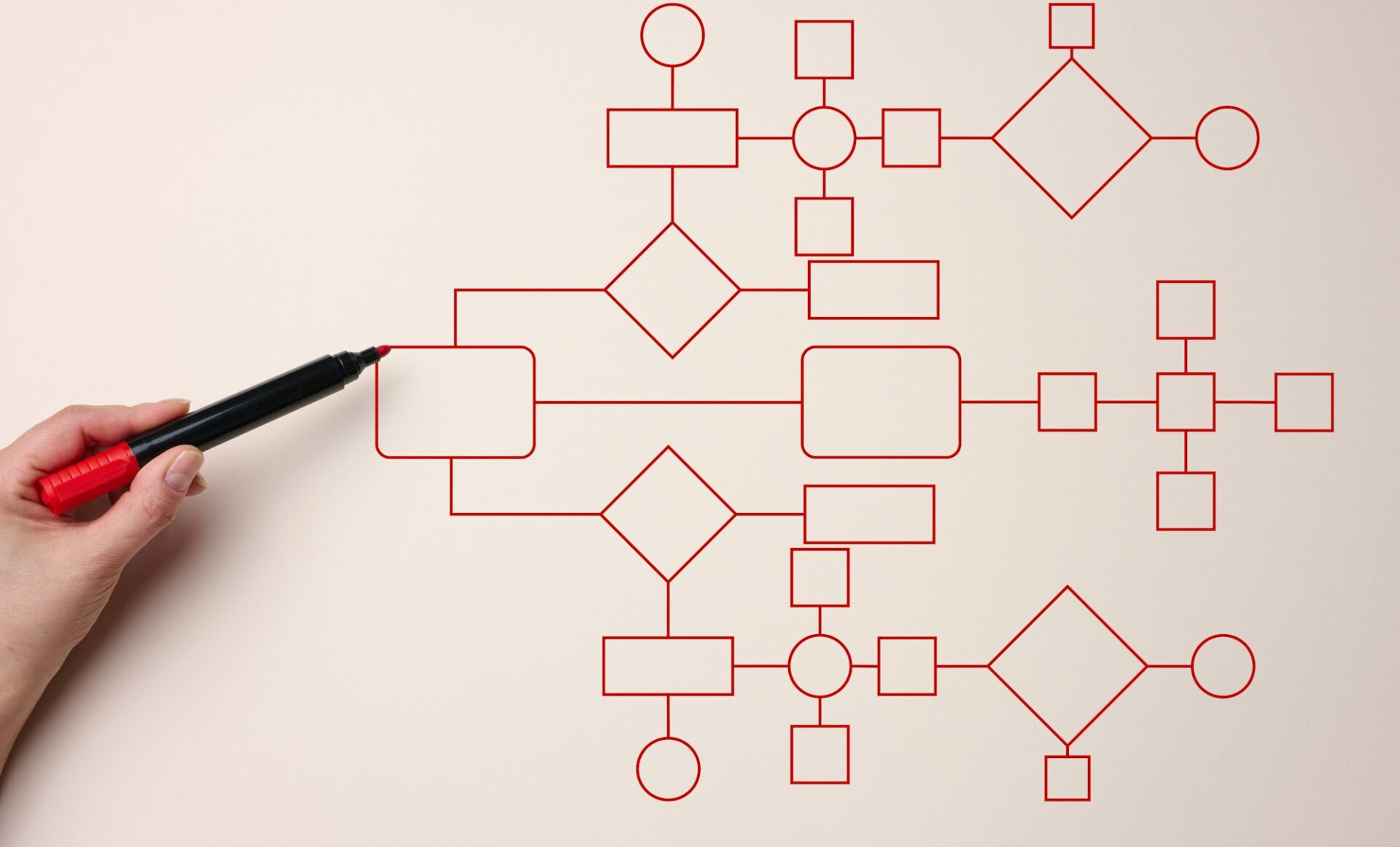
What is SEO & what does it include? | All about SEO in one blog
SEO, the abbreviation for search engine optimization, is a well-known term today and is becoming increasingly relevant. Let’s say you want to buy a washing

You probably found this blog by doing a search like “how does a search engine work” or “how does Google work” – where you entered that search is on a search engine. Google, Bing, Yahoo and others are search engines. Search engines are specialized computer programs that crawl the Internet, find information and make it accessible. They index websites and store the data in large databases. Put simply, when a user enters a query on a search engine (Google, Bing, etc.), the search engine analyzes the query and provides “relevant results” based on various algorithms. Search engines allow us to efficiently search and sort huge amounts of data.
Finding relevant information on the World Wide Web and providing it to users based on their query: that is the main task of a search engine. Factors such as keywords, page relevance and user-friendliness play a major role. Well-known search engines such as Google, Bing and Yahoo! have developed complex algorithms to improve the quality of search results and to provide accurate search results.

In addition to the well-known search engines such as Google and Bing, there are many others that offer different features and results. From those with a built-in VPN to environmentally friendly search engines. Fun fact: different search engines are preferred in different countries, for example Naver in South Korea or Yahoo! Japan in Japan. Here are some you should know:
These alternative search engines offer a variety of options depending on what you value – be it privacy, environmental friendliness or other. It is worth trying out different search engines to find the best one for you.

Search engines discover content through a process we call crawling. Crawlers, also known as spiders or bots, are automated programs that systematically crawl the web. They start with known URLs and follow links on those pages to discover new URLs. The goal of crawling is to find updated and new content on the Internet. This process ensures that the search engine’s index always remains up to date.
After crawling, indexing occurs. Indexing involves analyzing the content of each page, including text, images, and other media, and then storing them in the search engine’s database. During this process, the search engine extracts important details about the page, such as keywords, meta tags, and the overall relevance of the content. The indexed information is organized so that it can be quickly retrieved and displayed when users make queries.
Ranking is the final step in which the search engine determines the order in which the results are displayed. When a user enters a query, the search engine uses complex algorithms to evaluate the indexed pages and rank them based on relevance, quality and authority.
Factors such as keyword usage, page structure, backlinks and user interaction all play a role here. The aim of the ranking is to present the most relevant and useful results to the user at the top of the search results page.
Using these processes, you can quickly get accurate and up-to-date information about your search queries.

Search engine algorithms are the complex formulas and processes used by search engines to retrieve and rank information from the web. They determine which content is most relevant to the search query and the order in which the results are displayed.
Search algorithms analyze different parts of websites. They look at which parts are important for certain search queries. When a user enters a query, the search engine searches its index for suitable content and evaluates it based on numerous criteria. The results are then ordered and displayed according to relevance.
Search engines like Google use several algorithms to handle different aspects of the search process. Some of these algorithms focus on understanding the intent of the user, while others evaluate the quality of the content, the credibility of the source, and the positive user experience on the website.
Artificial intelligence (AI) and machine learning (ML) have become integral parts of modern search algorithms. They help search engines process large amounts of data and improve the accuracy of search results.
AI and ML help with:
Search engine algorithms are complex systems that aim to deliver the best and most relevant content to users. Understanding what factors influence search rankings and the role that artificial intelligence and machine learning play in this is crucial for anyone who wants to improve their online presence. As technology continues to advance, algorithms must also adapt. Therefore, it is important for digital professionals to stay informed and flexible.
Crawling is part of how search engines gather information from the internet. Web crawlers, also called bots or spiders, crawl the internet to discover and index content. Understanding the intricacies of how crawlers work is crucial for anyone involved in web design, SEO and marketing.
Web crawlers, often called bots or spiders, are automated programs that crawl the Internet and collect data from websites. They start with a list of known URLs and follow links to discover new pages. These crawlers form the basis of search engines and help them to create an up-to-date directory of web content. The main purpose of a web crawler is to find new and updated pages, follow links, and collect content that can be indexed and retrieved upon user requests.
Crawlers send HTTP requests to web servers, much like a user would access a website through a browser. However, unlike human users, crawlers do this on a large scale, continuously visiting and revisiting pages to ensure that the search engine’s index remains up-to-date.
Crawlers navigate the web by crawling, which involves several key steps:
Sitemaps and robots.txt files help control the crawling process. Sitemaps list the URLs of a website, while robots.txt files contain instructions on which pages not to crawl.

The indexing process allows search engines to store and organize the vast amounts of data collected from the Internet. The indexing process enables search engines to quickly retrieve and display relevant information. This article will explore the intricacies of the indexing process, highlighting how search engines store and organize data, the importance of keywords and metadata, and the challenges and limitations of indexing.
The process begins with web crawlers – Once the content has been collected, the indexing process begins, which involves several important steps:
Search engines filter out all the text content from the websites they search to form the basis of their indexing system. This process involves a detailed collection of headings, paragraphs, metadata and other text-based elements on a page. By comprehensively collecting all textual information, search engines ensure that they have a robust database that can support a wide range of search queries. This extensive text data is crucial to accurately match user queries with relevant websites.
Non-textual elements such as images, videos and embedded content are also thoroughly analyzed. Search engines use advanced techniques to understand the content of these media types. For images, they analyze attributes such as alt text and captions. For videos, they can use transcriptions, subtitles and even scene recognition technologies. This multi-faceted analysis enables search engines to interpret the context and content of media elements, allowing them to index and retrieve rich media results in response to user queries. This capability is particularly important as the web becomes increasingly multimedia.
In addition to text and media, search engines filter and analyze metadata from websites. Metadata includes elements such as title tags, meta descriptions and keywords that provide essential information about the content and purpose of a page. This metadata plays a crucial role in helping search engines understand the context and relevance of a page beyond what is visible in the main content. For example, a well-crafted meta description can significantly influence how a page is indexed and how it appears in search results. By utilizing metadata, search engines can improve the accuracy and relevance of search results and provide users with more accurate and useful information.
The process of identifying the right keyword helps search engines understand and rank websites. It involves the search engine’s ability to identify important keywords and phrases in the text of a website. To do this, search engines use algorithms that sift through the content and identify which words and phrases are most important and relevant to the overall topic of the page.
First, the search engine scans the text to filter out potential keywords. This not only considers obvious terms, but also synonyms and related phrases that add context to the content. The importance of each keyword is then evaluated based on several factors. These include how often the keyword appears, its placement in the text (for example, in headings or the first sentences), and the occurrence of the keywords in metadata such as title tags and meta descriptions.
In addition, the search engine evaluates how these keywords relate to each other and to the overall topic of the page. This involves contextual analysis, which considers the meaning and intent behind the words. For example, a page about “digital marketing” might also include related terms such as “SEO,” “content marketing,” and “social media.” By understanding these relationships, the search engine can more accurately determine how relevant the page is to specific search queries.
The identified keywords are then indexed, that is, they are stored in the search engine’s database along with information about their context and relevance. This allows the search engine to quickly retrieve and rank the page when a user searches for those terms or related topics. The efficiency and accuracy of this keyword identification process are critical to ensuring that users receive the most relevant and useful search results.
Keyword identification is not just about counting words, but about understanding and finding the relationships between words and the topics they represent. By effectively identifying and analyzing keywords, search engines can better match user queries with the most appropriate and high-quality web content.
Link analysis helps search engines understand the structure of a website and their relationships with each other. This process includes both internal and external links. Internal and external links are part of OffPage SEO optimization.
Internal links connect one page of a website with another page of the same website. They play a crucial role in the navigation and structuring of content. Search engines use internal links to understand the hierarchy and context of pages within a website. Well-designed internal linking helps search engines to find and index important content more efficiently. It also shows which pages are considered particularly valuable or central to the website. For example, the home page might be frequently linked to other important pages, signaling its importance.
External links, also called backlinks, connect one page to another website. These links are especially important for search engine optimization (SEO) because they serve as recommendations for the linked content. When one website links to another, it indicates that the linked content is trustworthy and valuable. Search engines consider the quality and quantity of external links pointing to a page as a measure of its authority and relevance. High-quality backlinks from authoritative websites can significantly improve a page’s ranking in search results.
Link analysis allows search engines to analyze the web and understand the interconnected structure of online content. By analyzing internal links, search engines can determine the structure of a website and the relative importance of its pages. This makes it easier to index and retrieve content more quickly. For external links, search engines evaluate the credibility and relevance of the links pointing to a page.
A page with numerous high-quality backlinks is likely to be viewed as more authoritative. This improves the website’s ranking. Conversely, links from low-quality websites can damage a page’s reputation and negatively affect its ranking.
This allows search engines to organize and structure websites by topic and focus, which improves indexing and retrievability. By using advanced algorithms, search engines analyze and categorize content into broad topics such as “education”, “sports” or “culture” and further into subcategories such as “online learning” or “Champions League 2024”. This structured approach improves the accuracy of search results and makes it easier for users to find relevant information quickly.
In addition, categorizing related content improves findability, which promotes a better understanding of topics. Nevertheless, the process faces challenges due to the diversity and complexity of web content, which requires constant adjustments to the algorithms. Content categorization for search result optimization is necessary and ensures that users receive the most relevant and useful information.
Once content has been thoroughly analyzed and categorized, the next crucial step is to store this information in a database.
Distributed databases are essential to managing the massive volume of data generated every second on the Internet. These databases span multiple servers and locations and work seamlessly together to efficiently store, manage, and retrieve information. This distributed structure ensures that data remains accessible even if one server fails, providing robustness and reliability.
To make retrieval efficient, each piece of information is carefully indexed based on various factors. Keywords play an important role here, as they help to identify the main topics and content. The relevance of the information is also taken into account so that the most relevant data is prioritized for search queries. In addition, the link structure, including internal and external links, is analyzed to understand the context and connections between different content.
The main goal of structured data storage is to enable fast and accurate retrieval. When a user enters a search query, the search engine can quickly search the indexed database, match the query with the relevant information and deliver accurate results in fractions of a second. This efficiency is crucial for a smooth and satisfying user experience.
The advanced indexing and storage techniques also enable search functions. Users benefit from features such as autocomplete suggestions, related search queries and personalized results, all supported by the extensive database and its intelligent organization. This not only improves the user experience, but also helps users find the most accurate information faster.
As the internet continues to grow, so does the amount of data. Distributed databases are designed to be highly scalable so that more storage capacity can easily be added as required. This scalability ensures that the system can handle growing amounts of data without sacrificing performance. In addition, continuous advances in database technology and indexing algorithms help to future-proof the storage system and keep it efficient and effective in the long term.
Search engines use complex algorithms to ensure that data is stored in a way that optimizes retrieval speed and accuracy. This includes the use of different indexing structures that enable fast search and retrieval of information.
Relevance: Keywords are fundamental to the relevance of search results. They help search engines match user queries with the most relevant pages.
Content understanding: By analyzing the frequency and context of keywords, search engines can understand the main topics and subtopics of a page.
User intent: Correct use of keywords helps search engines understand the intent behind user queries to provide the most relevant results.
Title tags: These provide a concise summary of the page content and are one of the most important elements for ranking in search engines.
Meta descriptions: Although not a direct ranking factor, meta descriptions influence click-through rate by providing a brief summary of the page content in search results.
Header tags: Tags like H1, H2, and H3 help structure the content, making it easier for search engines to understand the hierarchy and importance of different sections.
Alt text for images: This helps search engines understand the content of images, which is crucial for image search and accessibility.
Keywords and metadata act as signals to search engines, helping them to accurately categorize and rank pages.
Despite the technology of modern search engines, the indexing process faces several challenges and limitations:
Frequent updates: Websites that are updated frequently pose a challenge for indexing. Search engines must revisit these pages regularly to keep their index up to date. These continuous changes require significant resources to ensure that the latest content is captured and correctly indexed.
Websites with frequently changing content, such as news portals or blogs, are particularly affected, as their relevance depends heavily on the timeliness of the information.
AJAX and JavaScript: Content generated dynamically by AJAX or JavaScript can be difficult to crawl and index by search engines. These technologies often reload content after the initial page view, meaning that search engines may not be able to capture the full content immediately. This leads to gaps in indexing and can affect the visibility of the affected pages in search results.
Addressing these challenges requires continuous improvements in search engine algorithms and technologies to ensure that dynamic and frequently updated content is indexed as efficiently and accurately as static pages.
Redundancy: Duplicate content can confuse search engines and lead to inefficient indexing, diluting the ranking power of pages. When search engines find multiple versions of the same content, they can have difficulty determining which version is most relevant, resulting in suboptimal search results.
Channeling: Proper use of canonical tags is critical to managing duplicate content. These tags signal to search engines which version of a page should be indexed as the primary version. Correct implementation of canonical tags ensures that the correct version of a page is indexed, maintaining the page’s ranking power and improving search engine efficiency.
A well-organized page structure is crucial for effective indexing by search engines. However, certain structural issues can pose significant challenges.
Websites with poor or complex navigation structure can be difficult for crawlers to fully index. If the navigation is unclear or convoluted, search engine crawlers may have difficulty finding and indexing all pages. This can lead to some pages being overlooked, reducing the overall visibility and ranking potential of the website. Clear, simple navigation ensures that all important pages are accessible to crawlers and therefore also to users searching for relevant content.
Pages that are not linked from other pages, so-called orphan pages, can be overlooked by crawlers, resulting in incomplete indexing. Orphan pages have no inbound links, which makes them invisible to search engine bots during their crawl process. This can be problematic as these pages, although they may contain valuable content, will not appear in search results. Ensuring that all pages are connected through internal linking helps crawlers to discover and index them efficiently.
Slow loading times: Pages that load slowly can hinder the crawling process and lead to incomplete indexing. Search engines prefer fast pages because they provide a better user experience.
Mobile optimization: With the increasing use of mobile devices, search engines are prioritizing mobile-friendly pages. Websites that are not optimized for mobile devices can have indexing issues. Good mobile optimization is crucial to ensure that all pages are correctly indexed and visible in search results. Fast loading times and mobile optimization are therefore essential for effective indexing and improved visibility.
Robots.txt: Misconfigured robots.txt files can inadvertently exclude important pages from crawling and indexing. This can prevent search engines from accessing and indexing important content, negatively impacting a site’s visibility in search results.
Authentication: Pages behind authentication walls or those that require login credentials are usually inaccessible to crawlers. These pages remain unindexed, meaning their content does not appear in search engine results. Properly configuring access restrictions is critical to ensure that important pages are indexed while sensitive information remains protected. Accessible yet secure content is the key to a successful online presence.
Although search engines have significantly improved their ability to index images, videos and other multimedia content, challenges remain. Multimedia elements such as images and videos enrich the user experience but present unique indexing challenges. Search engines rely heavily on text to understand content, and non-textual elements therefore require proper keywording and the use of descriptive metadata to be indexed effectively.
For images, the alt text provides a textual description that can be read by search engines. This is crucial for accessibility and helps search engines understand the content and context of images. Without adequate alt text, images may not be indexed properly, reducing their visibility in search results.
Videos present a different set of challenges. Search engines can’t watch videos, so they rely on surrounding text, transcripts and metadata. Descriptive titles, tags and detailed video descriptions are essential. Including transcripts can significantly improve the indexability of a video as it provides searchable text that search engines can crawl.
In addition, the use of structured data tags for multimedia content helps search engines to better understand and index these elements. This can improve visibility in search functions such as image and video carousels.
Spam pages: Search engines need to filter out low-quality and spammy content to maintain the integrity of their indexes and combat spam. This task requires sophisticated algorithms capable of identifying and penalizing such content. Sites that produce large amounts of low-quality content to manipulate search rankings and spam pages can affect the quality of search results. By identifying and removing these types of content, search engines ensure that users receive relevant and high-quality information.
There are a number of factors that limit indexing, such as complex navigation and orphaned pages. You should consider these aspects to ensure that your website is optimally listed in search engines and accessible to users.

SEO, the abbreviation for search engine optimization, is a well-known term today and is becoming increasingly relevant. Let’s say you want to buy a washing

You probably found this blog by doing a search like “how does a search engine work” or “how does Google work” – where you entered

Anyone who runs a website knows how important visibility and a better ranking (listing) on Google is. A new study shows that over 25% of
webhead is a professional, experienced and dynamic web design & SEO agency based in Vienna. We are your competent contact for IT services such as WordPress, web design, website development & search engine optimization. A combination of passion, commitment, competence and quality makes webhead the perfect partner.
All information subject to errors, typing errors and changes
Wir rufen Sie spätestens am nächsten Werktag zurück!
Mit “Senden” habe ich die Datenschutzrichtlinien und die AGB webheads gelesen und stimme diesen ausdrücklich zu.
We will call you back no later than the next working day!
With “Send” I have the Privacy Policy and the GTC webheads and I expressly agree to them.